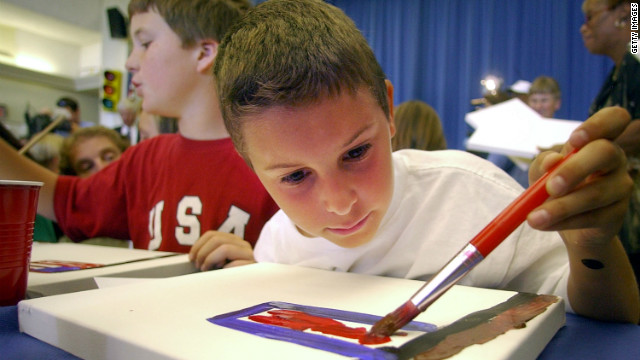School Leadership 2.0
A Network Connecting School Leaders From Around The Globe
Grading art in a standardized-test world By Katie Lyles

My View: Grading art in a standardized-test world
 By Katie Lyles, Special to CNN
By Katie Lyles, Special to CNN
Editor’s note: Katie Lyles has been teaching art in Jefferson County, Colorado, for seven years. In addition to her classroom duties, Katie has been part of her school’s cabinet, the Jefferson County Strategic Compensation Steering Committee, and the Leadership Academy for the Colorado Education Association. She was also a member of TURN and a delegate representative for JCEA. Katie is part of the steering committee for the Center for Teaching Quality’s New Millennium Initiative.
It takes a thick skin to be an elementary art teacher. And it’s not because of the clothes ruined by paint, the challenge of finding storage space for over 500 sculpture projects, or the glitter that sneaks into the most unlikely places.
No, what requires a thick skin is continually battling public perception that art—especially at the elementary level—is an “easy break in the day” for students. When I tell people that I’m an art teacher, I’m often greeted with a patronizing response that goes something like this: “Awwww! It must be fun to color all day!” That’s usually followed up with a stimulating question such as, “Do you have any students who eat glue?”
Truth be told, I do have fun coloring all day…while teaching color theory, elements of landscape, how to create visual interest through patterns, and the difference between a portrait and a still-life—and this is just with my second graders (who, by the way, have never attempted to eat the glue!).
Sadly, most people’s perceptions about art education come from their personal experience as students. Art classes look a lot different from a seven-year-old’s perspective than from a teacher’s perspective.
For one thing, teachers are responsible for measuring students’ competency and progress in art. With the assessment lens ever widening—and teacher evaluations often based on student performance on standardized tests—the question of how to assess subjects that do not have a standardized test attached to them is a complex but necessary question.
Some may be shocked to know that subjects like art are, in fact, tested, but not in a fill-in-the-bubble-while-your-palms-sweat way. I test my students in a variety of ways, which I believe leads to a more accurate evaluation than one-time standardized tests.
Using multiple measures may not be ideal for a quick, state-wide assessment, but from my experience, this “portfolio approach” yields more accurate results for a subject like art, where the concepts are demonstrated through project-based learning. A portfolio approach allows teachers to measure different projects and assessments by a student rather than just one test. This allows for a more accurate view of a student’s learning and growth because it uses a variety of assessments and data points to measure a student’s understandings.
Allow me the indulgence of describing my “perfect world” scenario for assessing art classes. Teachers would look at the following to evaluate students (and to improve our own instruction at the same time):
• Works in progress: Are students applying concepts and skills outlined in the curriculum guide? In art, it is important to measure the process and not just the final product because students demonstrate many concepts as they’re working. This formative evaluation leads to a more accurate assessment of a student’s understanding.
• Videos of student/teacher interactions: Video can help teachers look closely at students’ engagement during lessons, as well as identify and troubleshoot spots of confusion.
• Written answers to questions: Not only do written questions reinforce writing skills, but they assess students’ understanding of vocabulary, safety instructions, and overarching topics of instruction.
• Final project: How does the end product incorporate concepts and skills that were taught? Here, teachers are measuring demonstration of the outlined curriculum—meaning students don’t necessarily need innate artistic talent to meet the grade-level standard.
In this ideal world, technology plays a large role. Teachers can collaborate and learn from one another using online data banks of student lessons. Teachers in the same non-tested content area can use similar projects to increase reliability among the outcomes.
Online tools allow for the creation of online galleries that showcase not only students’ finished art products, but the learning process as well—which is so essential in a subject like art.
We already have a great information bank from generous bloggers who devote time to sharing their content area lesson plans. I’ve found projects outlined in a photo-gallery style that align with the curriculum content standards from my district, and have tried them out in my own classroom.
Not only can using online galleries help assess student work, they can also help connect parents to what’s happening in the classroom. Having an evaluation program like this would also help me improve, since I’d be able to see my teaching through an objective lens. Teaching colleagues could also comment and offer advice.
Best of all? The public can see for itself that my students don’t eat the glue.
The opinions expressed in this commentary are solely those of Katie Lyles.
JOIN SL 2.0
SUBSCRIBE TO
SCHOOL LEADERSHIP 2.0
Feedspot named School Leadership 2.0 one of the "Top 25 Educational Leadership Blogs"
"School Leadership 2.0 is the premier virtual learning community for school leaders from around the globe."
---------------------------
Our community is a subscription-based paid service ($19.95/year or only $1.99 per month for a trial membership) that will provide school leaders with outstanding resources. Learn more about membership to this service by clicking one of our links below.
Click HERE to subscribe as an individual.
Click HERE to learn about group membership (i.e., association, leadership teams)
__________________
CREATE AN EMPLOYER PROFILE AND GET JOB ALERTS AT
SCHOOLLEADERSHIPJOBS.COM
New Partnership
Mentors.net - a Professional Development Resource
Mentors.net was founded in 1995 as a professional development resource for school administrators leading new teacher induction programs. It soon evolved into a destination where both new and student teachers could reflect on their teaching experiences. Now, nearly thirty years later, Mentors.net has taken on a new direction—serving as a platform for beginning teachers, preservice educators, and
other professionals to share their insights and experiences from the early years of teaching, with a focus on integrating artificial intelligence. We invite you to contribute by sharing your experiences in the form of a journal article, story, reflection, or timely tips, especially on how you incorporate AI into your teaching
practice. Submissions may range from a 500-word personal reflection to a 2,000-word article with formal citations.
You need to be a member of School Leadership 2.0 to add comments!
Join School Leadership 2.0